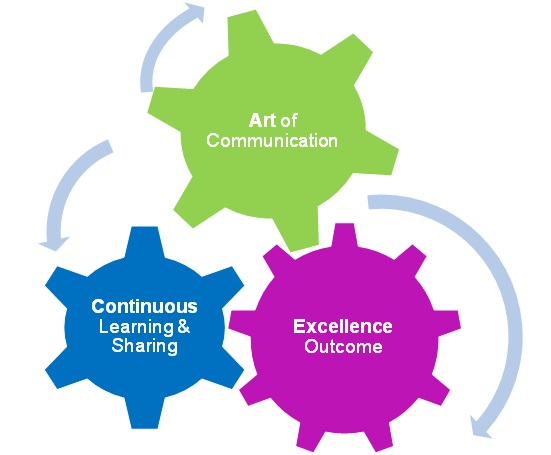A Coaching Model Created by Elaine Lee
(Health and Wellness Coach, SINGAPORE)
Coaching requires “Two to Tango” in “Striking a Chord”. Therefore, you need to connect and resonate with your client well as part of the chemistry in the coaching journey. To begin with coaching, the” Art of Communication” is essential to be effective throughout the coaching session. The language spoke should be easy to be understood by your client especially English is one of the common languages used in most of the countries. It is important to set the agenda right during the coaching agreement to ensure that the objective or goals of the client are aligned. Establishing trust and intimacy with your client is necessary in order to create a safe and confidential space for your client to be engaged in a coaching session. Providing a supportive environment that enhances ongoing mutual respect and trust to stay connected with your client.
Two-way communication is key for sharing of information, gathering of feedback and uncover the underlying beliefs of your client. Always encourage an open discussion to explore options to a solution and opportunity to generate ideas rather than leading or closed questions which may limit the client’s thoughts or having a different perspective that is irrelevant. Coaching is also a learning process to encourage your clients to speak out of their minds, thoughts, and emotions. As such, a coach should demonstrate respect for the client’s perceptions, learning style, personal being in providing ongoing support to take new challenges in their behaviors and actions.
To be effective in coaching, a coach should know how to determine if the client is engaged or disengaged for mutual understanding in enhancing a successful coaching presence. Creating a spontaneous relationship helps your client to feel at ease and adopting a coaching style that is open, flexible and confident. Maintaining two-way communication to speak slowly and clearly and listen to your client intently. In addition, active listening, powerful questionings, and direct communication are key elements to engage your client completely in strengthening an ongoing and trusting relationship. Be mindful not to be judgemental but acknowledged the client’s effort and motivational level or energy shifts. Give recognition to your clients whenever appropriate such as self-awareness, self-discovery or realization on behaviors, mood changes or perspectives.
Everyone needs a coach to be guided and supported on his/her goals or objectives. Every client is unique, a coach should adopt a different approach based on individual learning style and behavior so as to engage, connect and resonate with your client. Creating awareness invokes inquiry for greater understanding, awareness, and clarity.to think beyond or “out of the box” situation. Helps your client to discover new thoughts, beliefs, perceptions, emotions, moods to strengthen his/her ability to act and achieve the desired goals based on his/her agenda. Identifying the strengths and areas for key learning and development which are important to address any issues or resolution during the coaching journey.
Designing an action plan is necessary to hold your client accountable and committed to the goal-setting. Support your client throughout the entire coaching journey to ensure that an action plan is carried out, the deadline is set, and the goal is achieved. Encourage your client on self-discovery for learning outcomes and how he/she can apply in today’s coaching as discussed and learned for immediate actions or implementation. Partnership with your client to create a plan that is Specific. Measurable, Achievable, Realistic and Timebound (SMART). Managing progress and accountability are necessary to hold your client responsible and committed to taking actions in the goal-setting. Monitoring on the progress and development of your client on the coaching plan and desired outcome based on current and future coaching sessions. Celebrates the success and capability of your client’s progress or achievement whenever appropriate.
Here is an illustration of the “ACE Coaching Model” as part of the coaching tool to apply and use as a guide for my coaching session.
The Coaching Model: “ACE” It
Art of Communication: The “Art” of Communication requires two-way dialogue between a coach and the client in a coaching session. To communicate effectively; coaching presence is essential for active listening, powerful questioning, direct communication and using the right language during coaching sessions create a greatest positive impact on the client in building rapport and trust.ie
Continuous Learning andSharing: This leads to creating awareness and open an opportunity for action plans in goal setting. Sharing of individual unique talents, knowledge and skills or strengths in client’s daily lives through learning and interaction supports them in achieving their goals successfully. Invokes inquiry for greater understanding, awareness, and clarity to discover their underlying beliefs that strengthen the client’s ability to act and goal setting. Create an opportunity for ongoing learning, during coaching and in work/life situation enable the clients to undertake new actions to move forward and leads them towards coaching agreement and plans.
Excellence Outcome: “A goal without a plan is just a wish”. Planning and goal setting helps the client to align and attain the client’s values and life purpose in meeting the SMART Objectives. Manage the progress, holds the client responsible and accountable to deliver the outcome in achieving the ultimate goals. Celebrate success on the client’s achievement.
Let’s work together to “ACE” it.
The“ACE” Coaching Model

“Let’s Work Together to ACE It”